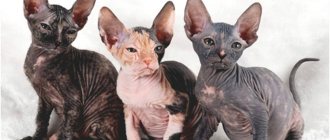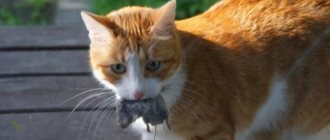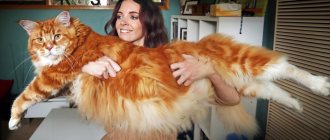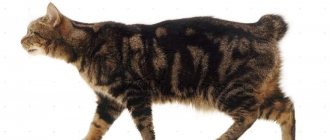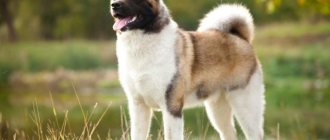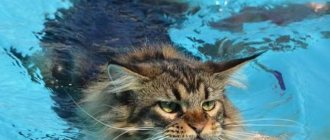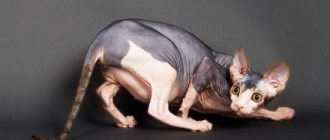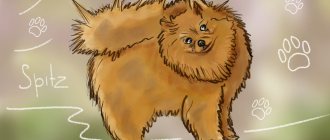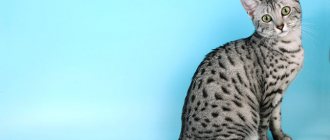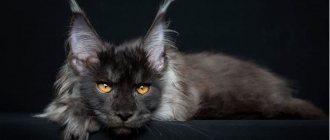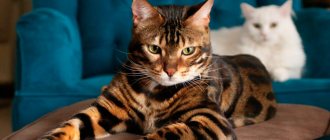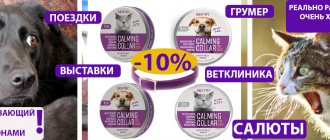People strive to get the best, unusual, exotic. This also applies to pets. Keeping wild animals at home is not the best idea; scientists have learned to mix them with pets and breed new species. Cats are especially susceptible to this process. To obtain a new species, similar to a wild animal, but safe for humans, various experiments are carried out. Lynx-like cats are popular now. Cute tassels on the ears have won more than one heart!
The history of cats with tufted ears
Almost every long-haired cat has ear tufts . As they grow older, the tassels disappear. There are several officially recognized breeds for which tassels are standard.
Scientists still cannot determine what these funny tassels on the ears are for - just for decoration or have any functional significance.
However, three theories are known :
- Brushes work as sound amplifiers and help cats amplify weak sounds and convey the source of noise with high accuracy. Thanks to this “accessory,” the animals became professional hunters, able to hear the faint rustling of small animals under the snow. However, the theory was smashed to smithereens several times, since the hairs are absolutely not connected with the senses.
- A tuft of hair on the ears serves as a kind of beacon , thanks to which cats recognize each other at a great distance. For example, the lynx has excellent eyesight, and its tassels help it spot its relatives from afar, even in the dark.
- The brushes determine the age of the cat - the longer and darker the hairs, the older the animal. But even in an adult lynx, the tassels can have a light shade, so the theory, in fact, has no connection with reality.
Many breeders are interested in the question: when did the first cat with tassels on its ears appear? All recognized modern breeds have their own history of origin, but officially the oldest tasseled breed is considered to be the Norwegian Forest Cat . Scientists admit that it was she who became the ancestor of Maine Coons.
However, illustrations from the era of ancient Scandinavian culture indicate that Norse cats accompanied the Vikings until the 16th century. In some legends, the god Thor traveled with a "fluffy forest beauty", whose description resembles a modern Norwegian cat. If you believe the Scandinavian sagas, the first representative of cats with tassels was the beautiful Norwegian.
Kurilian Bobtail
These cats appeared on the Kuril Islands, their main external feature is a short tail. Kittens are already born with it, it's a genetic trait. It is this short tail, fluffy collar and green eyes that give the Kuril Bobtail its resemblance to a lynx.
Peculiarities:
- Height up to 35 cm, weight up to 7.5 kg;
- They resemble dogs in behavior (loyal, affectionate, obey their owner);
- Excellent hunters;
- They love company and are perfect for families with children;
- Price from 10,000 rub.
Kurilian Bobtail
Cat breeds similar to lynx
The group of cats with tassels includes several breeds . Even the Neva Masquerade can acquire similar decoration.
Felinologists are confident that this is how the genes of our ancestors manifest themselves. The trait is not inherited, but appears randomly, so masquerade cats are not included in this group.
Caracal
Caracal is an oriental beauty with a wild and affectionate disposition . A mysterious, spectacular, graceful cat with a charming look will not leave anyone indifferent.
Most of the animals live in the wild . Domesticated individuals are rarely found.
This is an ancient species of cats living in Asia Minor and Central Asia , in the steppes and deserts of Africa, and in the Middle East. It is less common in Kyrgyzstan, Turkmenistan, and Uzbekistan; about 100 individuals live in the regions of Dagestan.
The name of the breed comes from the Turkic “kara kylak” , which in translation sounds like “black ear”. The back of the ears and tassels are painted black. The black border also runs along the inner edge of the ear.
Caracal is a cat breed similar to a lynx, distinguished by its large size : height at the withers 45-50 cm in height, body length 80 cm, tail length 30 cm. The body is strong, muscular, proportional, the paws are strong and long, covered with short, hard hair. The muzzle is elongated, wedge-shaped, the eyes are large, expressive, the ears are long, decorated with black tassels. Life expectancy is 15-18 years.
The wild caracal is a ferocious and unapproachable hunter, lightning fast, stealthy and strong. The domestic caracal is an affectionate and gentle animal, a friend and family pet . An important condition for successful socialization is education with love and respect, without physical punishment.
Caracals have excellent memory and developed intelligence . Cats love to go for walks, spend time with people, and be the center of attention. The representative of the breed is territorial, so stray dogs and cats are not allowed into a private home. The caracal gets along well with other pets, except birds and rodents.
Caracals have excellent health and rarely get sick , living to a ripe old age.
Caraquet
The caraquet is a domestic lynx cat similar to the wild caracal . American breeders tried to cross a domestic caracal with an Abyssinian cat. The experiment was a success. This is how the first hybrids of the second generation were obtained.
The second birth of the Carakets happened in the Russian city of Ivanovo. Breeder Irina Nazarova was inspired by the idea of breeding small wild cats. The crossing involved a young croak and a domestic cat.
Subsequently, representatives of the following breeds were used for breeding: Serengeti, Egyptian Mau, Abyssinian, and Oriental. As a result, the new breed developed distinctive features - large ears, long muzzles, excellent health and fertility.
The appearance of caraquets is colorful - they are quite large animals (9-12 kg) with strong long limbs , a wide nose, large eyes and huge black tufts on the ears. The color is uniform brown-red on the back and sides. A second generation of caracats is planned by crossing with Abyssinians in order to preserve the warm color and ticking.
Cats are completely devoid of aggression and are very sociable.
Important! Caracats cannot be declawed. They are great at retracting them, like many hybrids, so they don’t scratch or damage furniture.
Caracats inherit immunity from caracals, so they do not get sick and are not susceptible to genetic pathologies.
Maine Coon
The Maine Coon is a beloved breed native to Maine, USA. The cats are considered descendants of domestic shorthair cats crossed with Scandinavian cats . Felinologists trace a connection with the Norwegian forest cat.
The ancestral origin of the Maine Coon is unknown and is based on assumptions and legends :
- The breed appeared after the mating of a male cat and a female raccoon . As evidence, they cite the color of the tail, similar to the tail of a raccoon.
- The cats originally belonged to Marie Antoinette and were illegally imported into the United States.
- Maine Coons were created by crossing a North American lynx with a regular cat. The theory is confirmed by the presence of tufts on the ears, like a lynx.
Maine Coon is a cat with ears like a lynx, the breed is extremely large . Males weigh 6-10 kg, females 4-7 kg. The height is 25-41 cm, and the length reaches 120 cm, including the tail - 30-36 cm in length.
The body is strong, muscular, limbs are strong . The body is rectangular. Representatives of the breed mature slowly and reach their potential size by 3-5 years.
Maine Coons are curious by nature, sociable, but not annoying , and do not require special attention from the owner. Cats love to play with puzzle toys, look out the window, don’t mind walking on a leash, and are ready to accompany their owner on trips.
Cats adapt to any type of home , are not afraid of heat or cold, and are friends with dogs and cats.
Life expectancy is 9-15 years with proper care and a balanced diet.
Maine Coons have strong immune systems, but are predisposed to :
- hypertrophic cardiomyopathy;
- hip dysplasia;
- polycystic kidney disease.
Interesting. Maine Coons are silent and rarely meow. They usually “chirp” in high tones or emit melodic trills in a thin voice.
Pixiebob
The Pixie-Bob breed was created by an accidental connection between a cat named Pixie and a wild cat in 1985. The kittens were born tailless, which served as the starting point for the development of the breed. The breed received official recognition by the International Cat Association in 1994, and in 2005 by the American Cat Fanciers Association.
Adult cats are large, reaching 6-8 kg, females - 5-6 kg . Pixiebob is a kind, smart and playful animal that has absorbed the best qualities of cats. These cats are tireless participants in games, faithful travel companions, faithful friends and full members of the family.
The physique is massive, the chest is pronounced, the legs are short . The muzzle is wedge-shaped, the ears are of medium length. The coat pattern is striped. Life expectancy is 15-17 years.
Pixie-bob is an interesting breed of cat, like a lynx, which is distinguished by high intelligence and patience . These are soft and kind cats, adventurers by nature. They love to watch their owners' daily household activities - cooking, washing, cleaning. Pixiebobs normally perceive changes in situation and environment, are excellent at navigating the terrain, and have developed hunting instincts.
Representatives of the breed are generally healthy and not prone to genetic pathologies , despite the fixed short-tailed gene. Cats tend to be overweight, so they should not be overfed.
Interesting things on the site:
13 Largest Cat Breeds in the World
A cat like a leopard - what kind of breed is it?
Norwegian Forest Cat
It is not known exactly how the Norwegian forest cat appeared : either the Scandinavian goddess Freya cut through the clouds in a chariot drawn by six cats, or the animals appeared as a result of meetings between the Vikings and the Turks. If you believe the second theory, then the ancestor of the beautiful “Norwegian” should have been an Angora cat. There is another variant of origin - from a Siberian cat. In any case, the breed is ancient, indigenous, and developed in natural Scandinavia.
The harsh climate forced the animals to acquire warm, thick and long fur coats with dense undercoat, which allows them to withstand rain, snow and wind.
In the 30s XX century a group of European breeders set about creating a full-fledged breed with characteristic features. We didn’t think about the name of the breed for a long time. In their homeland, cats are called “Norsk Skaukatt”. Several individuals from the Norwegian Cat Fanciers Club participated in the exhibition in Oslo. The animals were received well and given high scores.
At the beginning of World War II, the breeding program was suspended and, unfortunately, most of the population became extinct. It took 40 years for breeders to become interested in Norwegian cats again. The breed received official recognition in 1993.
The Norwegian Forest Cat has a large build, long hind legs, a developed chest and muscles , and long ears with tufts. Animals can climb trees and hunt. In addition, they lead the lifestyle of an ordinary cat - bask in the sun, chew grass on the lawn, play with children.
The Norwegian cat has a stable and balanced character and a sharp mind . They are ready to give affection and warmth to all family members; they love to sit on laps and lie next to the owner.
Life expectancy is 12-16 years. The breed has strong immunity, but is prone to genetic diseases :
- accumulation of glycogen IV;
- hypertrophic cardiomyopathy;
- retinal dysplasiaNo.
- polycystic kidney disease.
Interesting. In Norway, cats are called "skogkatts", which translates as "forest cat".
Chausie
Chausie or Hausie is an unusual breed, a cross between the wild jungle cat Felis Chaus and the Abyssinian cat .
Crossing with a wild cat determines the cost of the breed - from 10 thousand US dollars. The breed is classified into 4 stages F1-F4 . The higher the number, the higher the percentage of wild blood. Kittens of the F1 group are obtained directly from crossing a jungle cat and an Abyssinian, F4 are no different in size from ordinary cats and have the maximum level of socialization.
These animals are large in size . The weight of males reaches 7-10 kg, females - 7-9 kg, and body length - 1 m. There are three types of colors - black, silver (ticked), tabby. The tip of the tail is invariably black. Elongated ears are decorated with tassels. The body is strong and flexible, the animals skillfully climb trees and make amazing jumps.
Chausie is a temperamental cat that cannot stand loneliness and prefers the company of its owner . Cats marked F3 and F4 are more suitable for home keeping, but in any case, animals will feel more comfortable in a private home with the possibility of free walking.
Chausies have retained the hunter's instinct; they are not afraid of water and swim skillfully . Cats get along well with dogs and other cats, but birds and fish are potential victims for them.
Some individuals have difficulty establishing contact with children due to innate aggression. They will not allow familiar or brutal treatment and extend their claws for protection.
Chausies have excellent health, they rarely suffer from infectious diseases and are not predisposed to genetic ones.
Kurilian Bobtail
The Kurilian Bobtail is a rare breed of cat originally from the Kuril Islands. By default, the breed is considered Russian . Outside of Japan and the Russian Federation, the Kurilian Bobtail is rare.
There are two varieties of the breed - short-haired and long-haired. The shorthaired bobtail was first registered 200 years ago in the Kuril Islands. Long-haired cats appeared later.
A distinctive feature of the breed is a short tail 5-13 cm long . The physique is massive, the body is strong, inclined forward, the paws are proportionally developed, the neck is of medium length, the head is wedge-shaped, large eyes, medium-sized ears.
The Kurilian Bobtail is a breed that never gets boring. This is a playful, smart, kind animal . Many qualities that appeared as a result of natural selection have been preserved to this day thanks to strong genes. Cats skillfully fish, swim freely, hunt well, and have an inquisitive and free character. They are affectionate and loving, quickly becoming attached to people.
The Kurilian Bobtail has excellent health and rarely gets sick . The gene responsible for the short tail does not cause genetic abnormalities. However, cats tend to be overweight, so it is important to control the quality and quantity of food.
Caraquet
Caracal (caracal + cat) is a hybrid of a male caracal and a domestic cat. Kittens inherit their appearance from their father, and their calm character from their mother. The breed was bred by chance 30 years ago, and in 2018, the first caraquet nursery was opened in Russia, in Krasnodar.
Peculiarities:
- Height up to 45 cm, weight up to 16 kg;
- Caracats cannot meow, they rather yap or chirp;
- The caraquet has dog-like habits: they fetch things, become attached to the owner, walk on a leash;
- They must be fed with small poultry and meat;
- Caracat can be type F1 (direct descendant of caracal), F2 ("grandson" of caracal, 25% wild genes), F3 (third generation from wild caracal, the most domestic and do not have the bright appearance of a wild cat);
- Price from 100,000 rub.
Photo of a caracat - a cat very similar to a lynx.
Breeding secrets
Cat breeds that resemble wild lynx are very popular. These are affectionate predators, capable of both attacking and being tame. Breeding animals of such breeds is quite interesting and profitable. The main thing is to arrange everything correctly, to take into account all the nuances.
- Only animals of the breed class are allowed to reproduce. The cat or cat must have good results in competitions and exhibitions. Make sure you have a complete package of documents, including a veterinary passport.
- The animal must be biologically ready to reproduce and reach a certain age. A lot depends on the specific breed; it is better to consult a veterinarian.
- To choose a partner, contact the felinological club. As a last resort, look for a suitable candidate at the same exhibitions.
- Kittens need to be kept in an appropriate environment. As they grow up, they must receive the necessary nutrition and care. If a kitten of a breed similar to a lynx does not communicate with people from childhood, then it may never get used to them.
- Always complete all paperwork. Kittens are expensive only under this condition. Don't forget about the mating agreement.
This is only possible if you have your own private home. It is better to build a separate house for the cats in the yard, where there will be everything they need. It should be warm, dry and clean, no drafts.
For a comfortable life for breeding animals and the development of their kittens, it is necessary to equip not only a recreation area, but also places for active games. It is recommended to fence off the area outside so that animals can roam. Of course, maintenance will require a lot of money and patience, but the result is worth it.
For interesting facts about Maine Coon cats, watch the following video.
Anatomical characteristics
This breed can have up to seven toes on one paw.
Pixie-bob cats have a number of anatomical features:
- The body is medium-sized or larger, large-boned, strong chest.
- The weight of cats can be up to 10 kg, and in cats up to 5 kg.
- The muscles are developed, the body is strong with a curve at the back. When walking, the scapular parts stand out. create a feeling of impressive graceful gait.
- The hind paws differ from the front paws in height, are large, round in shape, sometimes there are cats with 6 or more toes;
- Short tail, within 6 cm. Kinks are allowed, but a straight one is better.
- The head is pear-shaped, wide at the top with a narrowing towards the nose, the chin is courageous.
- The nose is voluminous, long, and stands out strongly.
- The ears are of impressive size, widely spaced, turned outward, with tufts at the ends.
- The eyes are almond-shaped, far apart, light brown or green in color.
- The coat is profuse, sticking out above the body, and can be long or short. Soft and elastic.
Pixiebob
Breeders bred this breed artificially because they wanted to get a domestic cat that looked like a lynx. For this purpose, forest cats were crossed with domestic cats. The result was a pixie-bob breed: strong bones, black rims around the eyes, a short tail and gray coloring with blurry spots. Lynx in miniature! But by nature, pixie bobs are very gentle.
Peculiarities:
- Height up to 35 cm, weight up to 8 kg;
- Very active, love to play for a long time and walk on a leash;
- Almost 50% of pixiebobs have extra toes. This is a genetic trait;
- They love water;
- Price from 15,000 rub.
Pixiebob
Knitting features
Caracats are extremely difficult to breed. Males up to the fourth generation are sterile; only females can participate in reproduction. Most often, large males of the Abyssinian breed are selected as partners. But Oriental Shorthair, Serengeti and Egyptian Mau are also used. When working with hybrids, it is not always possible to obtain the desired result; sometimes the offspring are unsuccessful.
For mating they take Abyssinian, Serengeti, Ocicat cats
While selection work continues, only professional breeders are engaged in breeding this difficult breed.
Health and susceptibility to disease
On a walk
The lifespan of pixiebobs is about 12-15 years. They are in good health and in good physical shape.
Heredity is good, so diseases along this line are extremely rare. There have been cases of diseases of the genitourinary system, as well as heart disease. To prevent diseases, you need to be regularly examined by veterinarians, and when buying a kitten, find out about the diseases of the parents.
Breed defects
Description of appearance defects due to which an animal may receive fewer points:
- The belly is dark.
- The length and smoothness of the coat is inconsistent.
- Lack of distinct eyebrows and chin.
- Ears are not large enough or set too high.
- Distorted head shape, too flat forehead.
- Inconsistency in the bend of the legs.
- Not wide hips.
- The skin pouch on the abdomen is not pronounced.
- The back is too flat.
- The tail is either too small or too long.
Active and playful cats
. Vices that prevent you from obtaining a title:
- The color or pattern of the coat does not meet the standards.
- The presence of a wool collar.
- Irregular eye shape.
- Too thin build.
Disadvantages leading to disqualification:
- No tail.
- The tail is too small or full length.
- Presence of more than 7 toes on the paws.
Species of wild cats Manul
Have you never seen this animal or even knew about its existence? You haven't lost much, but this cat's appearance will fascinate you. This is a wild steppe species that lives in Asia, in particular in its central part and in Western China, Tibet, and Mongolia. Today, the Pallas' cat is still little studied by scientists, but its appearance, similar to a domestic Persian cat, indicates a certain relationship with this species. Whether this is actually true or not is difficult to say, but the beauty of this animal is simply mesmerizing.
If you look at the appearance of these cats, then their slightly gloomy, stern expression on their face immediately catches your eye. However, this does not cause fear; on the contrary, many argue that this beast looks very funny. And in recent years, its popularity has increased so much that even the concept of “manulomania” has appeared. Of course, no one is indifferent to the manula's ears with tassels.
In terms of body size, the Pallas cat is very similar to an ordinary domestic cat; the average weight ranges around 4-5 kilograms. The Pallas's cat has lush fur, as in the photo, short legs, so in winter it looks quite voluminous. The color of the animal is light gray with white tips of the hair, there are separate dark stripes throughout the body. Today there are three types of Pallas's cat, which differ in color: Siberian Pallas's cat, Tibetan silver and Central Asian red.
Every year the number of Pallas' cats is decreasing, so today there is a whole program for the protection and preservation of the species. Don't forget that these cats are wild, so there is no way to tame them. They live only in harsh wild conditions, as well as in zoos.
American Bobtail
This is a relatively new breed that appeared in the States in the 60s of the 20th century. From childhood, kittens look like little lynxes: they are born with short tails and fluffy wings on their cheeks. The spotted or striped color gives it an additional resemblance to a lynx. The American Bobtail has hind legs that are slightly longer than the front legs, like a lynx. Therefore, even the gait resembles a trot. Despite all this, the American Bobtail is a very gentle and domestic creature.
Peculiarities:
- Height up to 30 cm, weight up to 6 kg;
- Quickly find a common language with people, cats, dogs;
- They become attached to a person;
- They tolerate moving well and adapt quickly;
- Price from 10,000 rub.
American Bobtail
Hurry up, choose a box and find out what gift awaits you
Discount on pet insurance
Promo code copied to clipboard
"Aborigines" from the Isle of Man
This is roughly the name given to the Manx cats that settled on the Isle of Man in the Irish Sea. How they got there is not known for certain, although there are many versions: from biblical to modern scientific.
Today there are 4 varieties of Manx. Depending on the length and shape of the tail, cats are divided into:
- Rampi (sacral). The tail is completely absent.
- Riser (growth). Instead of a tail, there is only a small protrusion on a couple of vertebrae. -9
- Stumpy (short). A small tail measuring 4-8 vertebrae.
- Longi (long). Quite a long tail, almost identical to the “classic” length.
- Rumpy
- Stumpy
- Riser
- Long
If we talk about character, animals are cheerful and energetic. They love active games, love to climb trees and have enviable jumping ability. The habits of cats are somewhat similar to dogs, in particular, this concerns learning various commands. Since Manx cats are very sociable, they are not recommended for people who are rarely at home.
Another distinctive feature of this breed is its excellent hunting qualities. Owners of such pets should be calm about the fact that prey in the form of mice, rats, moles and other garden and dacha “fauna” will be brought into the house. Manx cats will always find a common language with children, even when the baby is too persistent in showing his love and tormenting the cat with annoying caresses.
Character and habits
Smart and well-mannered cats,
Piskibobs are trusting, gentle creatures. They consider the family in which they live to be their pack, become very attached, and love every member of the family. They need to be in the center of events, love attention and cannot live without communication. They are very bored when they are left alone at home, patiently waiting for their owners. They are very loyal.
Pixie-bob cats are playful, active and fun-loving. Capable of carrying toys in their teeth. They love to jump and climb trees. They always come when called.
They are very smart, think well, and are curious. They respond to human speech with meows, specific sounds just like servals.
They adapt to the life schedule of their owners. In the kitchen they behave in a balanced and calm manner, patiently waiting to be fed.
How to choose the right kitten
This is a very rare breed; if you decide to buy a kitten, it is better to do it in a specialized nursery, where, with the help of accompanying documentation, they will confirm the purebred origin of the kitten’s breed. In the nursery the pedigree will be immediately clear. There you can also find people with whom you can consult. In addition, there is always a choice and you can choose a kitten that is visually most suitable for a person.
The first step in choosing a kitten is to determine your goals. To participate in various exhibitions you need to buy a show-class kitten. Pixies of this class will exactly comply with all norms and standards.
The breed class will not become real champions due to some inconsistencies in external characteristics. But they can participate in different shows and become good producers.
The Elf kitten is weaned from its mother later than other kittens.
There is also a pet class. Cats of this class cannot participate in reproduction or exhibitions. But if this is not the main goal and you want a faithful, devoted, affectionate friend, then this is the right choice for the future owner.
Kitten care
Pixiebobab kittens are fully cared for by their mother, a cat. The change of ownership occurs no earlier than three to five months. At this time, the kitten should already be vaccinated, treated against various parasites and helminths, developed and well-fed in accordance with its age.
